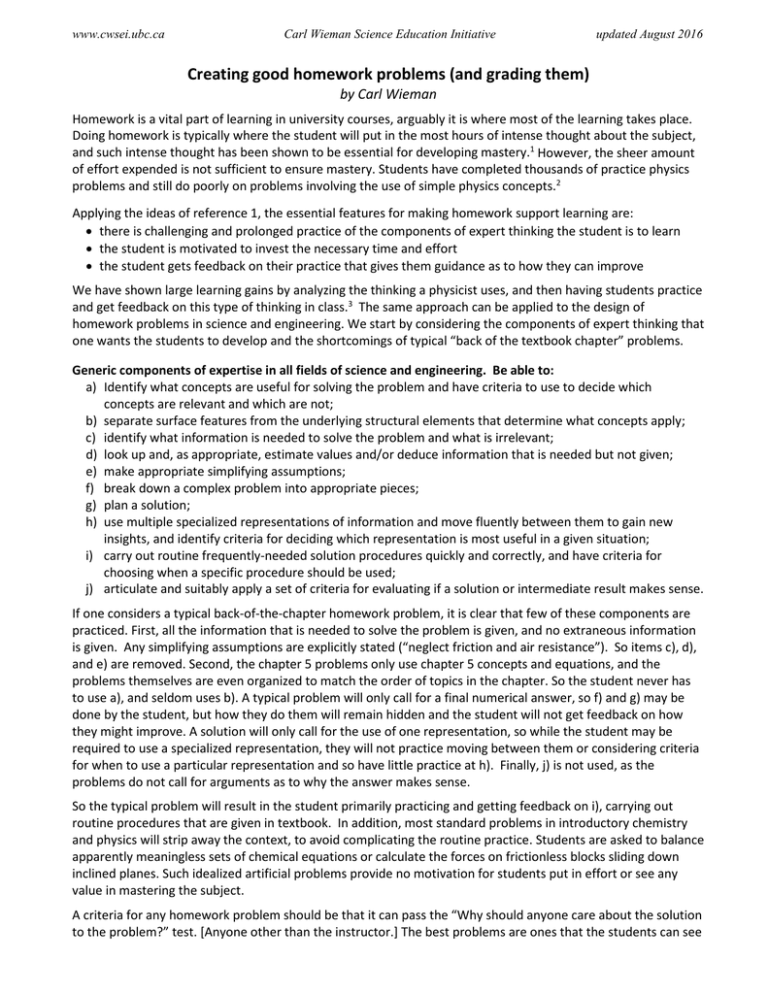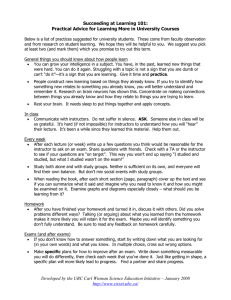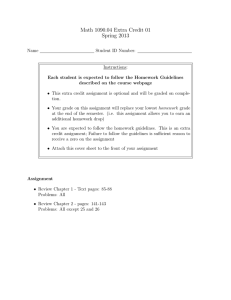Creating good homework problems (and grading them)
advertisement

www.cwsei.ubc.ca Carl Wieman Science Education Initiative updated August 2016 Creating good homework problems (and grading them) by Carl Wieman Homework is a vital part of learning in university courses, arguably it is where most of the learning takes place. Doing homework is typically where the student will put in the most hours of intense thought about the subject, and such intense thought has been shown to be essential for developing mastery.1 However, the sheer amount of effort expended is not sufficient to ensure mastery. Students have completed thousands of practice physics problems and still do poorly on problems involving the use of simple physics concepts.2 Applying the ideas of reference 1, the essential features for making homework support learning are: • there is challenging and prolonged practice of the components of expert thinking the student is to learn • the student is motivated to invest the necessary time and effort • the student gets feedback on their practice that gives them guidance as to how they can improve We have shown large learning gains by analyzing the thinking a physicist uses, and then having students practice and get feedback on this type of thinking in class.3 The same approach can be applied to the design of homework problems in science and engineering. We start by considering the components of expert thinking that one wants the students to develop and the shortcomings of typical “back of the textbook chapter” problems. Generic components of expertise in all fields of science and engineering. Be able to: a) Identify what concepts are useful for solving the problem and have criteria to use to decide which concepts are relevant and which are not; b) separate surface features from the underlying structural elements that determine what concepts apply; c) identify what information is needed to solve the problem and what is irrelevant; d) look up and, as appropriate, estimate values and/or deduce information that is needed but not given; e) make appropriate simplifying assumptions; f) break down a complex problem into appropriate pieces; g) plan a solution; h) use multiple specialized representations of information and move fluently between them to gain new insights, and identify criteria for deciding which representation is most useful in a given situation; i) carry out routine frequently-needed solution procedures quickly and correctly, and have criteria for choosing when a specific procedure should be used; j) articulate and suitably apply a set of criteria for evaluating if a solution or intermediate result makes sense. If one considers a typical back-of-the-chapter homework problem, it is clear that few of these components are practiced. First, all the information that is needed to solve the problem is given, and no extraneous information is given. Any simplifying assumptions are explicitly stated (“neglect friction and air resistance”). So items c), d), and e) are removed. Second, the chapter 5 problems only use chapter 5 concepts and equations, and the problems themselves are even organized to match the order of topics in the chapter. So the student never has to use a), and seldom uses b). A typical problem will only call for a final numerical answer, so f) and g) may be done by the student, but how they do them will remain hidden and the student will not get feedback on how they might improve. A solution will only call for the use of one representation, so while the student may be required to use a specialized representation, they will not practice moving between them or considering criteria for when to use a particular representation and so have little practice at h). Finally, j) is not used, as the problems do not call for arguments as to why the answer makes sense. So the typical problem will result in the student primarily practicing and getting feedback on i), carrying out routine procedures that are given in textbook. In addition, most standard problems in introductory chemistry and physics will strip away the context, to avoid complicating the routine practice. Students are asked to balance apparently meaningless sets of chemical equations or calculate the forces on frictionless blocks sliding down inclined planes. Such idealized artificial problems provide no motivation for students put in effort or see any value in mastering the subject. A criteria for any homework problem should be that it can pass the “Why should anyone care about the solution to the problem?” test. [Anyone other than the instructor.] The best problems are ones that the students can see www.cwsei.ubc.ca Carl Wieman Science Education Initiative updated August 2016 provide solutions that are obviously relevant and useful to their immediate surroundings or intended future careers, but admittedly that can be a high bar. However, it is not so difficult to find some meaningful task a person in some occupation would need to carry out that utilizes the knowledge and skills involved in the problem. If you find yourself unable to find any such context, you should ask yourself why you are bothering to teach this material. I have dropped more than one topic from my courses after confronting such a realization. The other design criteria for good homework problems are that the problems and the required solutions explicitly involve all the items, a) to j) above, as mapped onto the context of the specific content and concepts and solution procedures that you want students to master. There may well be others aspects of expert thinking you also want to include, both more discipline-specific aspects and less (e.g. “be able to write an articulate wellreasoned explanation”), depending on your learning goals. As you incorporate the design features a)-j) in your homework problems, make them an explicit part the solution that students are required to produce (or stand-alone problems for specific features). For example, a part calling for a list of the concepts that apply and what features of the problem determine that choice, a part asking for what quantities/information are needed and estimates for values of any quantities not given, what procedures or techniques will be employed (Fourier transformation, use of multiple equations with multiple unknowns, …), approximations to be used, justification for why the answer makes sense and the criteria used to support that justification. This means a solution will involve far more than something like a simple number or fact. It provides them with far more explicit practice and feedback on how to develop and improve expert skills than does producing a single number which they find out is correct or not. Grading homework Such detailed solutions can be challenging to grade if one has many students and little support. There are various options for reducing the grading burden. 1) Computer grading. Many parts of such a problem can be computer graded if one structures them appropriately. For example, asking what concepts apply can be made into a multiple choice question, where the options are the 20 or so concepts covered in the entire course and students have to choose all that apply. These same choices are given for every problem like this. One can have a similar list of perhaps 10 or so criteria to use in checking if an answer or intermediate result makes sense. These sorts of more demanding multiple choice computer graded problems can be made even richer by having ranking or ordering tasks of the items. 2) Grade selectively. For problems or parts of problems where it is too difficult to put them in computer graded form, grade some fraction (1/2-2/3) just according to whether or not they turned in a solution, and grade the remainder on correctness with more detailed feedback. 3) Use peer grading, in which students grade each other’s solutions. There are computer programs to facilitate the process. Two documents with resources and guidance on student peer review are posted on the CWSEI website at http://cwsei.ubc.ca/resources/instructor_guidance.htm#assess. Having students attend to feedback on homework Students attending to feedback and using it to improve is vital for learning. We have found three simple ways to encourage students to do this. 1. For any question on which a student loses points, give them the option of getting some fraction (1/4-1/2) back by turning in an explanation of what was incorrect about their thinking that resulted in the error. 2. Have each homework set contain a “reflection” problem such as, “Review your previous homework and the solution set, and then list all the problems you did incorrectly, what you did that was incorrect on each of those problems, and what you need to do differently on future problems of this type. If you did all the problems correctly, identify how you could improve a solution or which problem was most difficult and explain why.” 3. Have the exam problems be very similar to homework problems and advertise to the class that this will be the case. It is easier to do this if you have good explicit learning goals for the course where it is clear that both homework and exam problems are testing the achievement of the learning goals. References: 1. A. Ericsson, R. Krampe, C. Tesch-Romer, Psychological Review 100, 363-406 (1993); 2. T. Byun and G. Lee, Am. J. Phys., Vol. 82, 906 (2014); 3. Deslauriers, Schelew, and Wieman. 2011. Science 332:862-864


